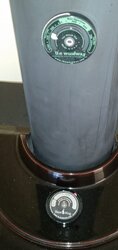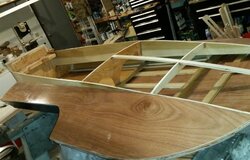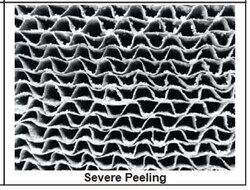The only information of value from the cat temp meter is whether the cat is active or inactive. Otherwise ignore it.
Your wood is not too dry. Just load and burn per the manual.
Seems that your problems are self inflicted. Relax.
Ok. Yes I can do that, did a relatively instrumented burn today. What I haven't done effectively is communicate the 'problem' I am having with super dry wood. Please bear with me.
I loaded, oh 75% capacity, in a cold stove after early church. About the same amount of wood as I can plan to load on hot coals deeper into winter. It was +40 something dF outdoors when I lit the stove, +72dF in the house. Our forecast high today was +50dF (sounds about right), I am back down to +32dF right now at 1030pm.
First confound, I have learned to pile my wood in the back , light the front of the pile top to bottom and save as much VOCs as possible for later in the burn. The official BK video on youtube wants me to get every split charred on every surface while the loading door is still open. I can do that too, but I get better (longer) burn times if I heat the cat up to active just by burning the front face of the blob of cord wood stacked tightly in the stove.
Today I lit the front of the pile and had minimal to moderate charring going on the rest of the load when I got the cat hot enough to go active.
I have a magnetic thermometer on my flue pipe about a foot above the stove, but I am using double wall telescoping flue pipe. I have read several times that the actual temp of my flue gasses is "about" double that shown on my magnetic surface reading thermometer. I have no idea what the temp of my flue gasses is really is. Numbers subsequently reported are actual readings - of the magnetic probe on DW pipe.
In "winter" I use a box fan on the floor in the hall to push cold air out of the floors of the bedrooms towards the stove. I spend 5-6 months annually tripping over that fool thing and haven't trotted it out yet this year. The only fans i used today in 1200sqft is the fan kit on the convection deck.
My thermostat for "house temp" reading is 12 horizontal feet from the stove down the hall towards the bedrooms, and 5 feet off the floor. My perception of my wife's wardrobe is calibrated to this interior temp reading. She is out of town this w/e, but I have a pretty good idea of how much clothing she wears relative to that thermometer.
So I am happy with the whole stove, bypass door clamping force, clean pipe, freshly vacuumed combustor, blah blah blah.
Lit it up, got it hot.
At T=0 the cat probe was at the notch between active and inactive, the house was +72dF, flue temp was reading "400". I closed the bypass door to engage the cat.
At T +3 minutes the flue temp was "350" and the cat probe indicator was 1/4" above the notch between inactive and inactive. So clearly the combustor is working.
At T+5 minutes the the flue temp was "300" and the cat probe was 1/2" above the notch. So far so good. I don't need to get down on my knees (again) to see if the cat is glowing. I have adequate redundant data showing me the combustor is working, and I got arthritis.
At t+30 minutes the flue temp was down to "225", my combustor was not over fired. In fact, it looked like this:

Notice the word "active" on the cat probe indicator, I didn't twist it today.
With the conditions above at T+30 I turned the Tstat down to medium, turned the convection fans on to medium, and opened all the bedroom doors on this level of the house. House temp was +73dF, up one degree already.
At T+65 minutes, 76 in the house, "150" flue temp, cat indicator about 3/4" above the active notch.
At T +136 minutes, 80dF in the house (my combustor is working just fine), "200" for the flue temp, cat probe indicator above the E in "active", higher thn it was at T+65.
At T +191 minutes, 83 in the house (very happy wife), "175" flue temp and the cat probe indicator at the A in "active".
At T +240 minutes (four lousy hours) I had 85 in the house, "175" for flue gas temp, and the cat probe 1/4" below the A in active.
At this point the wood in the firebox is burned down far enough to do a hot reload on a good bed of coals.
At T +300 minutes ( 5 hours) I had enough coals left to do a 'high maintenance' hot reload that would take 20 minutes instead of 5 minutes, but no matches or kindling required.
At T +10 hours (600 minutes) aka now, the cat has been inactive for hours. I probably wont need a match to get the cat hot again if I load it up right now, but I would need some paper under the kindling.
What i am seeing is if I fill the stove in the AM and go to work deeper into winter I am going to have a cooling cat already below the A in active when I start my lunch break. By the time I get home for a reload I am going to have an inactive cat.
At 12-16%MC this would have been a 10-12 hour burn with outdoor ambients in the neighborhood of -20dF, given my static insulation envelope.
So where did my burn time go? Dryer wood is suppose to waste fewer BTUs because there is less water to heat up, convert to steam and pump up the chimney.
I _think_ what I am up against this year is figuring out how soon I can turn the Tstat down to medium. Some number less than 30 minutes that increases my burn time (back to 'normal') without blowing the glass out of the door and setting my living room carpet on fire.





 Also, I don't see any "closed or plugged" cells in the "severe" pic...
Also, I don't see any "closed or plugged" cells in the "severe" pic...

